Ferrara: Florence’s Renaissance rival still puts on a show
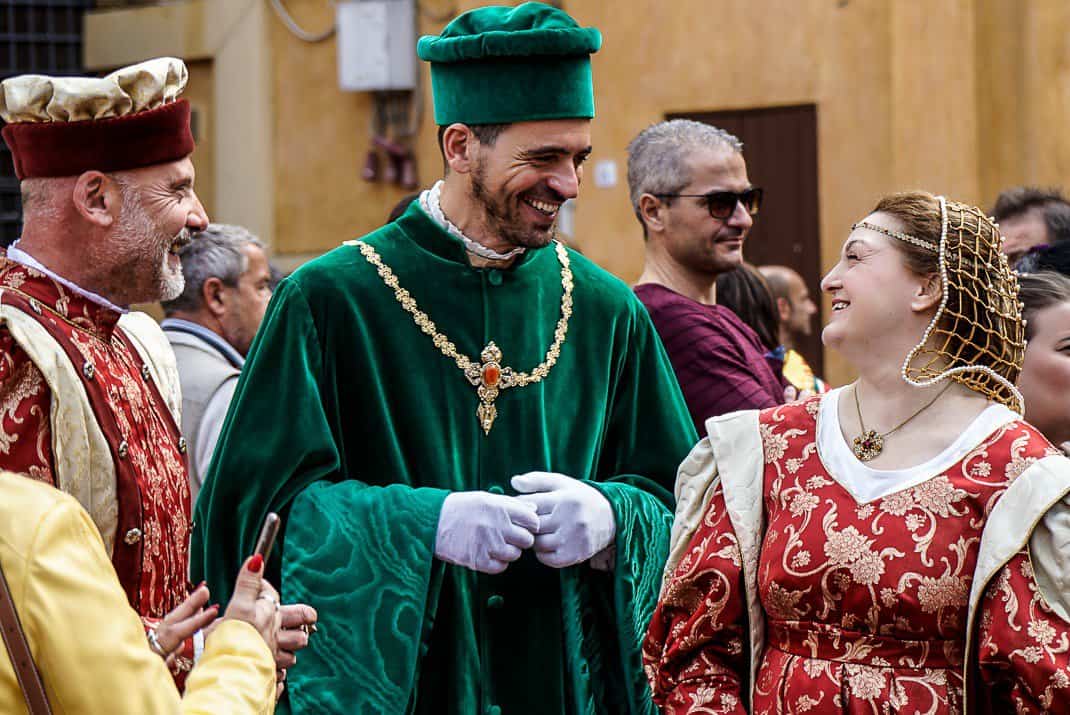
FERRARA, Italy – What is it about castles that makes me want to drink scrog? And what is scrog? I have no idea. But I know it’s always served in big wooden goblets. I want to walk around in big billowy clothes the colors of rainbows and squire around women in large hats.
And where else can you get in the mood for a beheading? Or at least a good art museum.
Put the castle in the middle of a decent-sized town in Italy and I feel like I’m in one continuous Renaissance Festival. In Ferrara, it seems like the Renaissance never left. It’s ever present. From the 14th century castle in the middle of town to the national museum filled with Renaissance art to its oozing with wealth today, Ferrara bridges old and new glory, even if it’s a span of more than 600 years and two earthquakes.
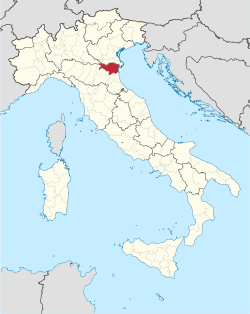
Marina and I came here last weekend for the eighth anniversary of our first date. It’s a yearly tradition to pick somewhere in Italy for a weekend getaway. Positano. Procida. Venice. San Gimignano. Cagliari. Yes, the best thing about living in Italy is you can celebrate anniversaries in Italy. This year we chose Ferrara, a lightly trodden city that’s a UNESCO World Heritage Site and the perfect stopover between Bologna and Venice.
Few do. Then again, few know that during the Renaissance Ferrara was a rival of Florence. I didn’t. Nor did I know this city of 132,000 is covered with palaces. It has city walls surpassed only by those in Lucca. And have you ever tried pumpkin-filled ravioli?
Ferrara is an easy reach. It took our train from Rome less than three hours, with a change in Bologna. After checking into our pleasant, simple bed & breakfast just inside the walls, we walked farther into the center for our traditional arrival beer.
The first thing we noticed was the streets. Ferrara’s streets are stone. Not evenly cut stones you see in other Renaissance cities. These are oblong, misshaped little boulders floating up in a sea of concrete. It’s like walking on one long rock garden. I viewed the few joggers running by me with equal parts admiration and fear for their ankle ligaments.
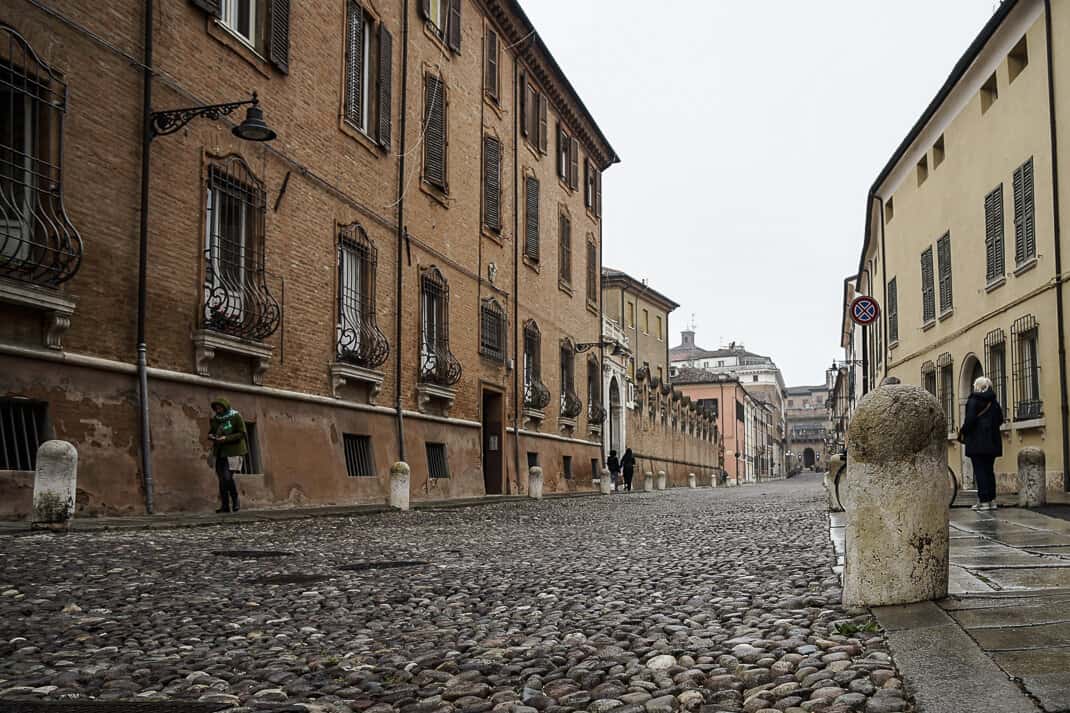
We wound our way through the narrow, crooked alleys until we reached Piazza del Gusto. A giant tree and a stone, oval fountain anchor a piazza with outdoor cafes and stone benches. Oblivious students couldn’t tear their noses out of their cell phones. Moms sat talking with daughters. Couples drank coffee. I had a local Pitona beer in sunny 60-degree weather.
I don’t believe in heaven but springtime in Italy is pretty close.
The castle
Every Italian city has piazzas but few are dominated by a castle the size of Ferrara’s. From our table, Castello Estense (also called the Castle of St. Michael) sticks out above the trees like a space station. Built in 1385 by the powerful House of Este, it has four matching cornerstone towers with views of the town and countryside. It even has a drawbridge over a moat big enough to hold a swim meet.

I thought that any minute I’d see Florentine troops storm the walls, dodging fireballs flying down from the ramparts. The Este family built the bridge to protect them from a citizenry furious over raised taxes. I wondered how many angry Ferrarese in the late 14th century could swim.
In the late 15th century it became the Estes’ home and as we crossed the drawbridge to enter we saw signs on doors marking current city officials. The city turned the castle into a 21st century office building.
Like the other half dozen museums in Ferrara, everything in the castle has Italian and English descriptions and you could fill a book with all the info on the Este family. The family roots connect to the duke of Bavaria, the Russian emperor Ivan VI and Holy Roman Emperor Otto IV.
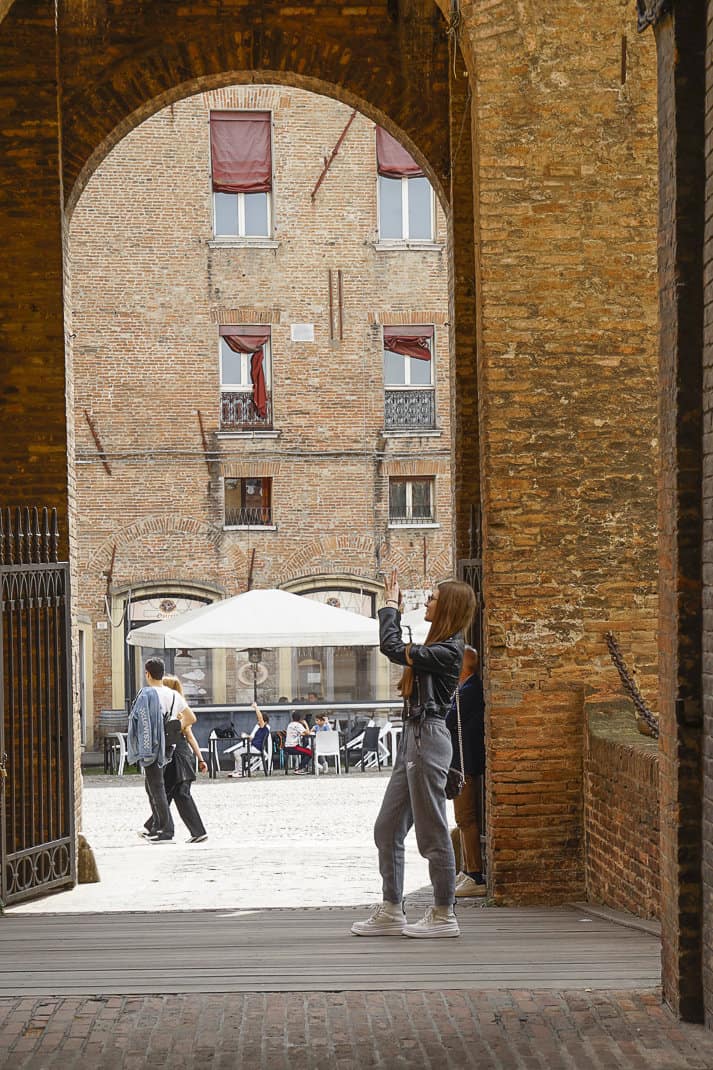
Then while Michelangelo was becoming a rock star in Florence, the House of Este was turning Ferrara into a cultural capital as well. Numerous popes visited Ferrara and their ever changing lords. Casanova once stayed here. Lord Ercole, a patron saint of the arts, lifted Ferrara into a legitimate art city in the 15th century. It later became well known for music and sciences until Pope Clement VIII rolled into town, took over and incorporated it into the Papal States in 1598.
Today the castle took us first to the original kitchen where holes of the six ovens still stand. Then it goes down into a narrow, dark dungeon that opens into a cell with crumbling walls 30 feet high. It is here where Duke Nicolo III d’Este beheaded his second wife and son for sleeping together. No, she wasn’t breastfeeding.
Ugo was 20.
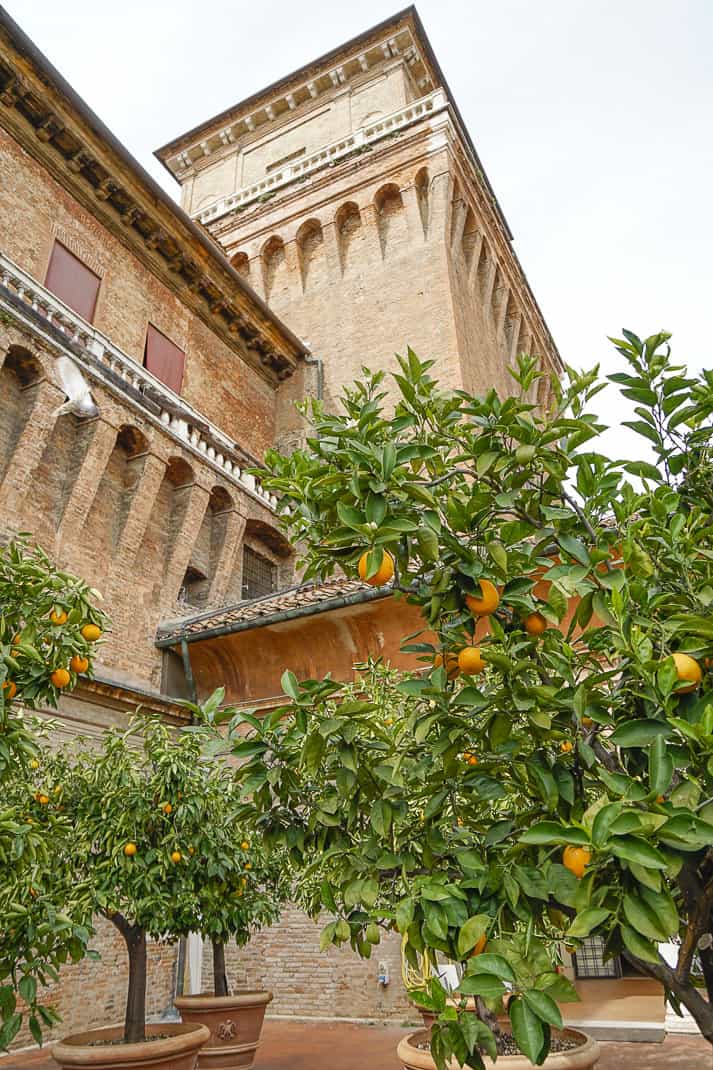
After a claustrophobic dungeon that was no more than 6 ½ feet high by three meters long, it was nice to rise into the beautiful courtyards. Potted orange trees with fruit hanging on fresh vines greeted us as did gorgeous views of the moat below and the tower above.
Beautiful frescoes lined the ceilings as we passed too many rooms and Italian-English descriptions to count. We climbed the 122 steps up the Torre dei Leoni to the bell tower where we had a panoramic view of Ferrara’s sea of red tile roofs.
Ferrara is definitely Florence light, with a fraction of the tourists. We had the tower viewpoint nearly to ourselves.
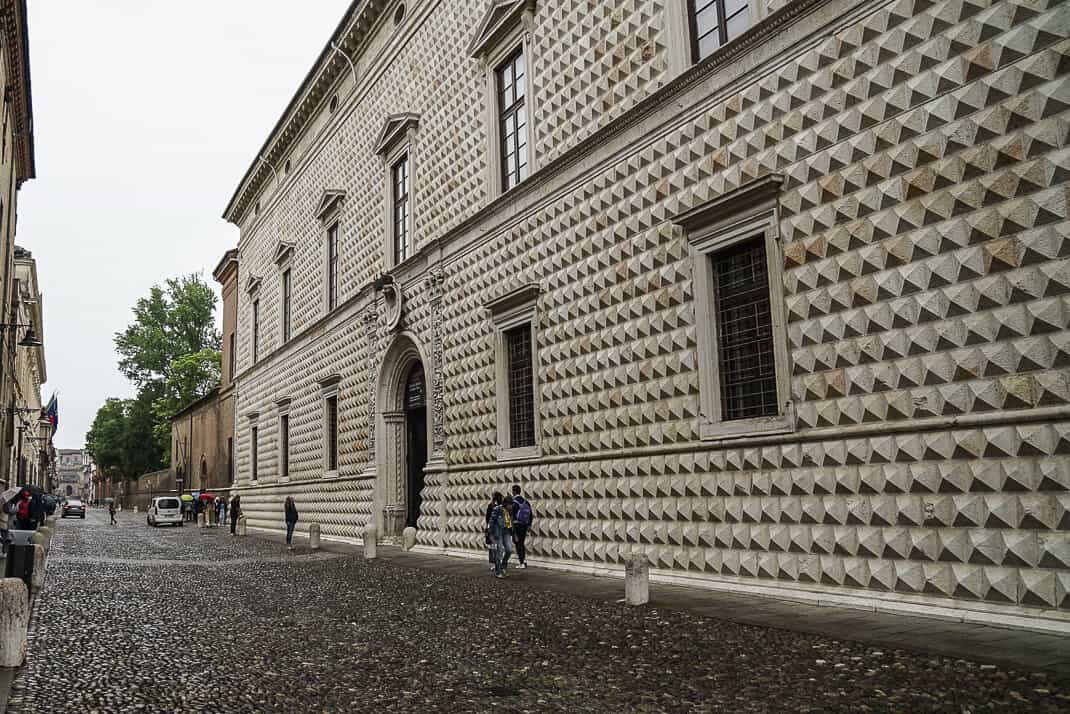
Pinacoteca Nazionale
For a major art fix, we went to Ferrara’s national art museum in Palazzo dei Diamanti, named for the thousands of pointy diamonds lining the outside of the 15th-century palace. This museum has 19 rooms, each with elaborate bilingual descriptions.
It’s mostly a collection of the little-known Ferrara school from the 16th and 17th centuries. I saw lots of bloody portraits of martyrs about to be fileted, such as the Martyrdom of St. Mauritius from 1489 and Jael killing Sisera. We passed through the Hall of Honor which in 1565 housed Don Cesare, the last Este to live in the palace before the Papal States took over.
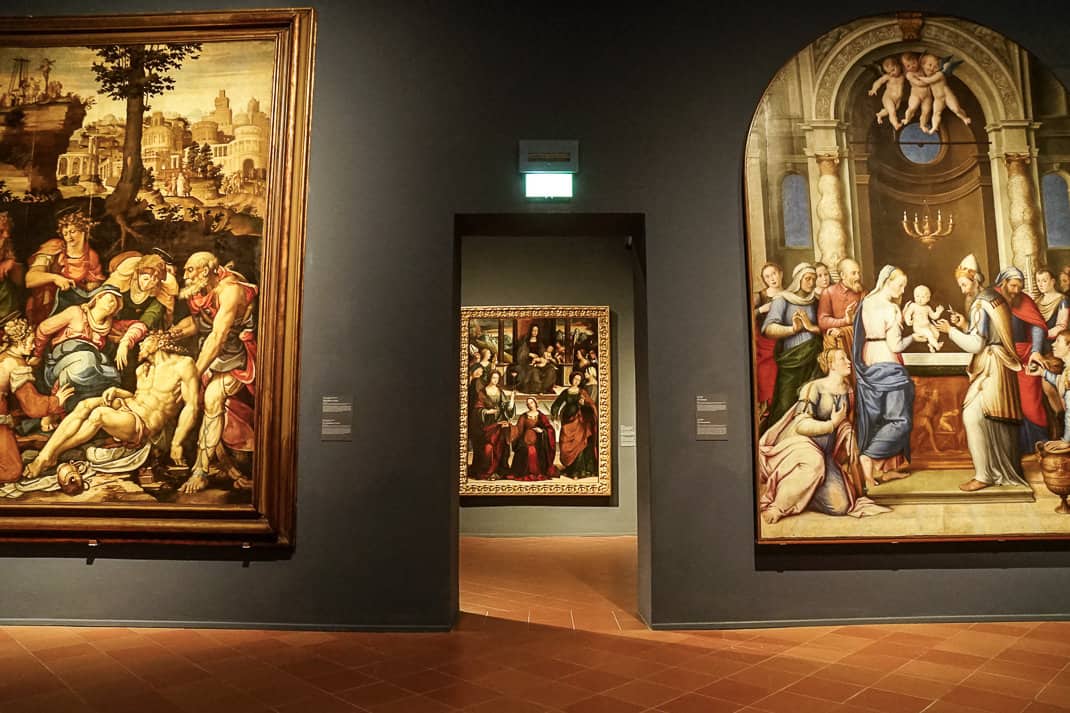
The city shows no signs of two devastating earthquakes that hit the Emilia-Romagna region. One in 1570 killed 130-150 people and leveled chimneys, terraces and severely damaged the castle. Another in 2012 killed seven, including four in a factory in Ferrara, and left 5,000 homeless in the region and damaged 100 historical structures.
All the construction we saw around town wasn’t earthquake repairs. It’s just a sign of a town with enough money to improve. Ferrara boasts an average annual income of €37,600, more than 20 percent more than the national average.
In fact, they even opened a new highly acclaimed museum in 2017. The Museo Nazionale dell’Ebraismo (National Jewish Museum) was built in renovated buildings of Ferrara’s prison from the 1900s. It traces Italian Judaism from 2nd century B.C. in Rome to Ferrara’s own Jewish Ghetto which existed from 1627-1859. It maps the Jews moving north on the peninsula after the Fall of Rome.

Interestingly, while Jews were being persecuted around Italy in the 16th century, the ruling Spanish offered Jews tax breaks if they moved to the coastal city of Leghorn (Livorno in Italian) and developed its economy. The town had no ghetto and the city’s Jewish community became the second largest of Iberian descent next to Amsterdam.

Night life
Ferrara has a pulse to it. At night, the rocky streets have people pouring out of bars drinking the bright orange colored Spritz made famous in Venice 60 miles to the north. After dinner one night we stepped into tiny Antico Cafe. Jonathan, the owner, bought the place after tiring of working in discos.
He said mayor Alan Fabbri has been a huge plus to the city. Elected in 2019, he not only guided the city through Covid but he also made Ferrara a music center, starting the Ferrara Summer Festival two years ago. Black Eyed Peas will play this July. Bruce Springsteen plays May 18 in Parco Urbano Bassani just outside the north city wall.
Jonathan introduced me to a young blond man in a stylish brown-leather jacket. Francesco Morelli, 21, was headed to Los Angeles for acting school the next day, a life change he summarizes with “I know the streets I grew up are older than all of U.S. and to me this is fucking mind blowing.”
He was born and raised in Ferrara to a mother who did the same. I asked him what he likes about the town.
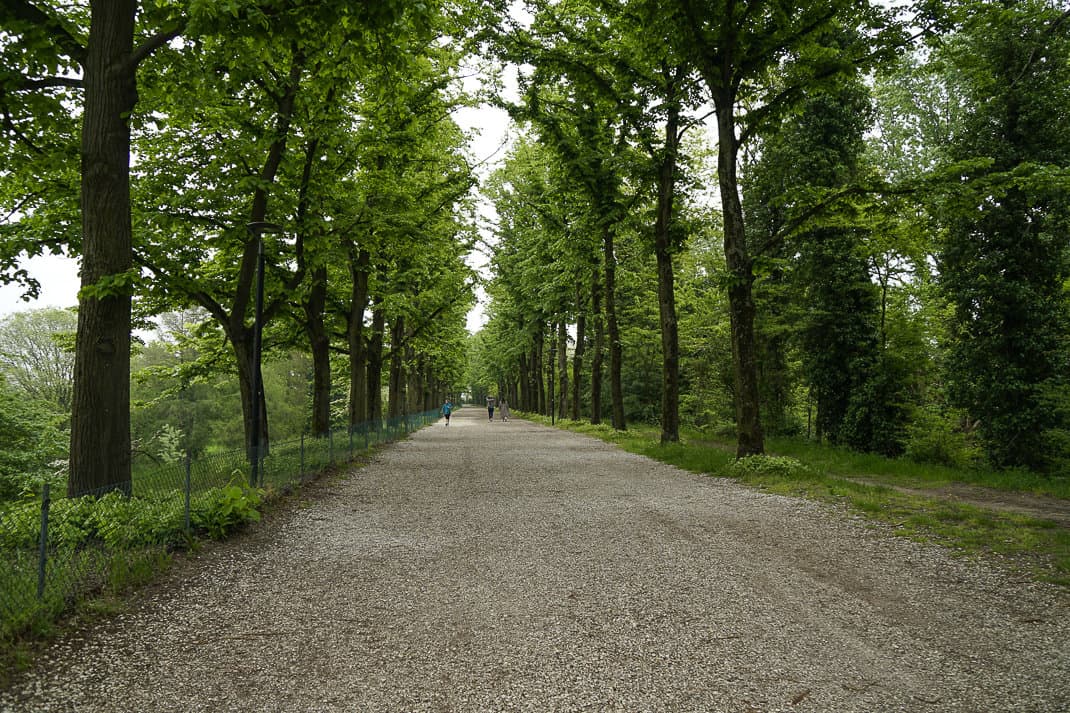
“The good thing about Ferrara is it’s not that big,” he said. “It’s not that small so it’s the perfect size. I am 21 years old and don’t have a license because I don’t need a license. With my bike, with my foot, it’s a place where everything is comfortable for me.”
He said the summers are horribly humid. It’s built over a swamp and it’s true. Ferrara is only 30 feet above sea level 35 miles away.
But April can’t be beat.

The food
Emilia-Romagna is famous for the best antipasti in Italy. Think Parma ham and parmesan so fresh, they’re often served in balls which you eat like apples. Antipasti plates are pre-dinner musts.
But Ferrara has its own unique cuisine. We first went to Ca’ d’ Frara, (Ferrarese dialect for House of Frana). It’s a modern restaurant with long, stylish, metal lamps hanging from the ceiling. Soft jazz filled the air. We shared an antipasto of thin slices of Parma ham spread out over a five big pieces of puffed pastry.
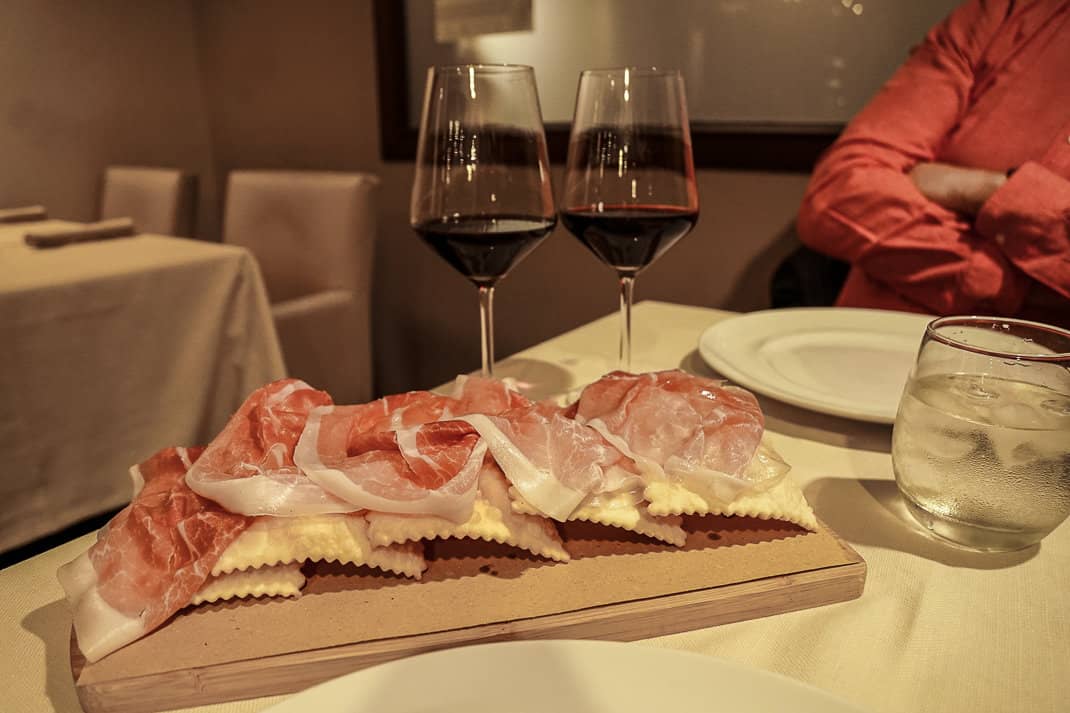
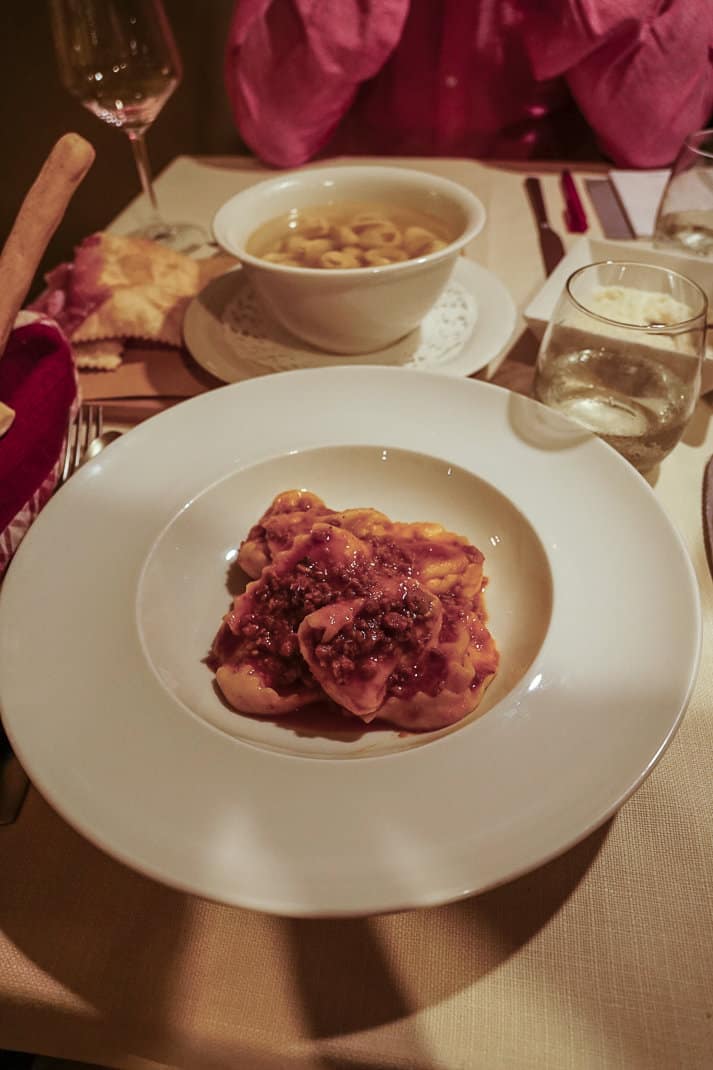
For dinner I had Ferrara’s trademark dish, cappellacci di zucca con ragu (ragged-edged ravioli filled with pumpkin in meat sauce). I loathe pumpkin. A pumpkin should be carved, not eaten. But combined with the meaty sauce, the pumpkin actually is sweet, a very tantalizing taste.
The next night I tried the other famous dish at Trattoria da Noemi in an ancient building with wood beams and black and white lithographs of old Ferrara. Pasticcio di maccheroni is baked macaroni with meat covered in parmesan inside a thin crust. It’s basically a macaroni pie and the perfect light meal.
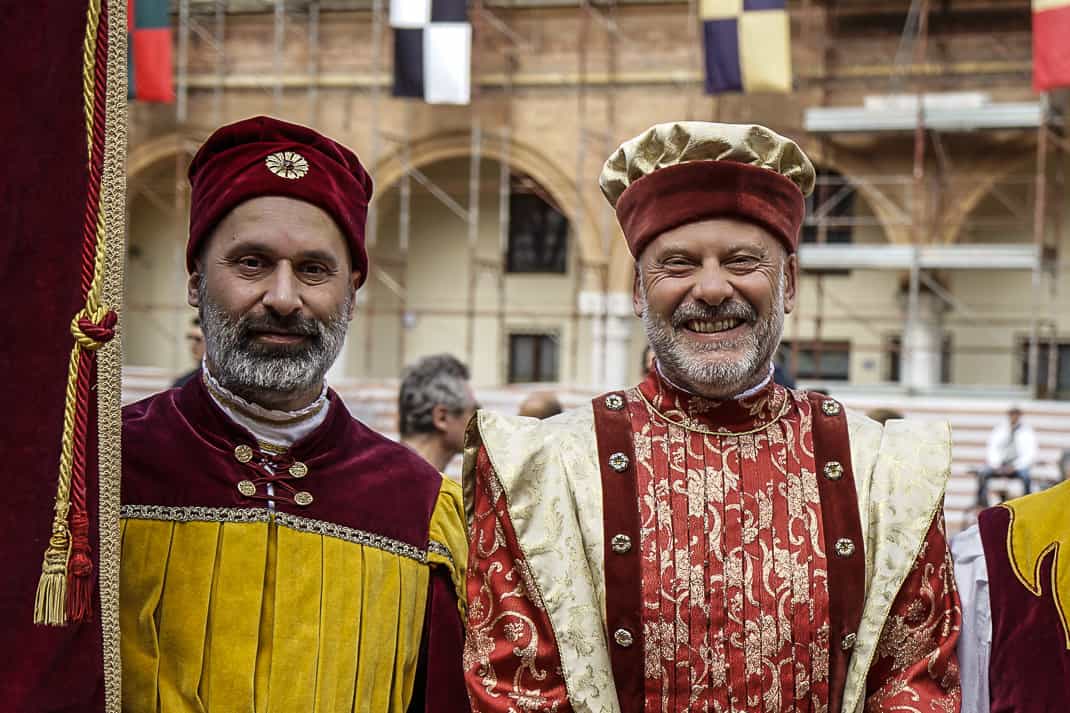
Before returning to the station for our trip home, we took our daily coffee at Duca di Este, a stylish outdoor cafe next to the castle. On the castle grounds hundreds of people gathered for the Omaggio al Duca (Tribune to the Duke). The city’s eight districts gather to sell local food products and gifts and perform in native costumes. And there they were, young boys and men of all ages juggling flags (one with his legs) and running around the grounds carrying huge flags.
They wore big billowy clothes the colors of rainbows.
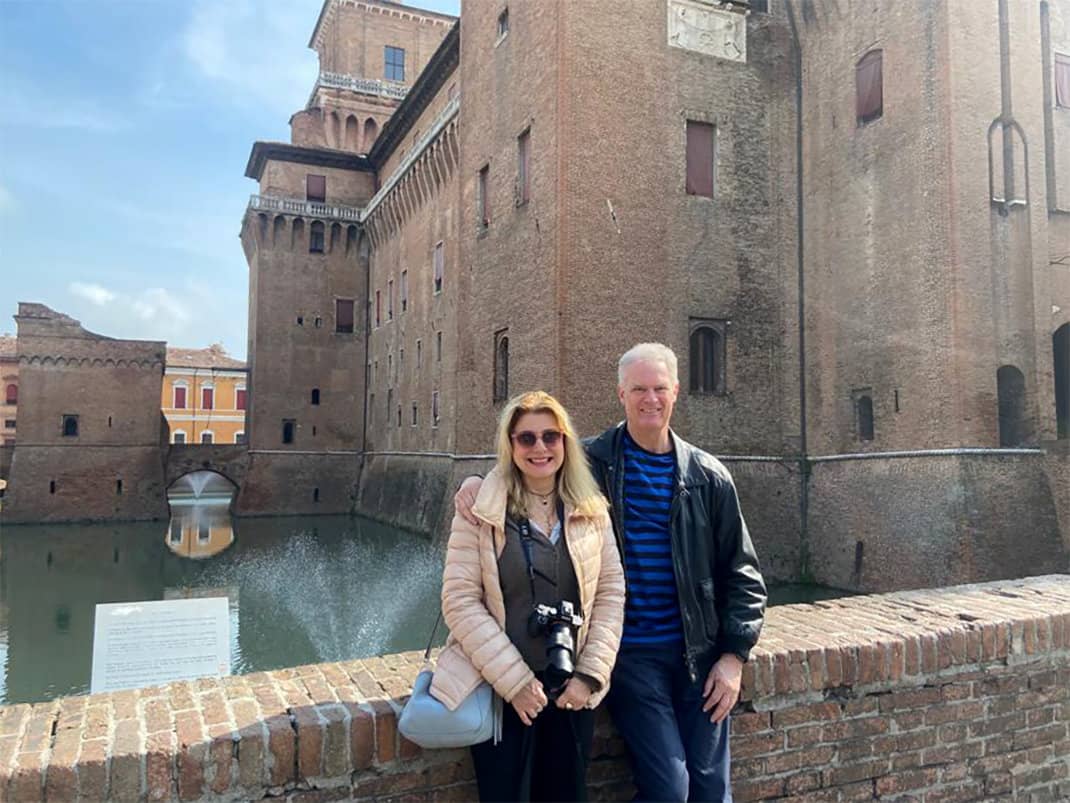
If you’re thinking of going …
How to get there: Italo has numerous direct trains from Rome. The 2-hour, 52-minute journey is €29.90 with a week’s advance purchase and €65.90 within a week. From Milan, Trenitalia has a four-hour trip with changes in Piacenza and Bologna for €21. A two-hour trip with a change in Bologna is €46.80.
Where to stay: Ferrara Rooms, Via Ripagrande 83/A, 39-342-944-2533, www.ferrararooms.it, info@ferrararooms.it. A small hotel on a quiet street just a 10-minute walk from the castle. Includes pre-ordered breakfast. A sauna is available for €20. I paid €230 for two nights plus €6 tax.
Where to eat: Ca’ d’ Frara, Via del Gambero 4, 39-05-342-205-057, www.ristorantecadfrara.it, 12:15-3 p.m., 7:15-11:30 p.m. Friday-Monday, 7:15-11:30 p.m. Wednesday-Thursday. Antipasti plates for €16 and local pasta dishes starting at €12.
Trattoria da Noemi, Via Ragno 31/A, 39-05-32-769-070, www.trattoriadanoemi.it, info@trattoriadanoemi.it, 12:30-2:30 p.m., 7:30-10:30 p.m. Thursday-Monday, 7:30-10:30 p.m. Wednesday. Local cuisine with pasta dishes starting at €10.
Time to go: July and August are hot and humid with average highs of 88. January is cold with lows of 32 and highs of 44. April was nearly perfect in low 60s with some rain.
For more information: Tourist Office, Viale Cavour, Castello Estense, 39-05-32-209-370, www.ferraraterraeacqua.it, infotur@comune.comacchio.fe.it, 9 a.m.-6 p.m. Monday-Saturday, 9:30 a.m.-5:30 p.m Sunday.


May 2, 2023 @ 10:14 pm
Ferrara football team (S.P.A.L.) has a very interesting story.
May 11, 2023 @ 8:30 am
That story will get more interesting. SPAL is about to get relegated.
May 4, 2023 @ 3:41 pm
Thank you for sharing a Spring festival experience in a lesser known Italian Renaissance town! This is a great shoulder season destination alternative to the checklist cities on most traveller lists.
May 11, 2023 @ 8:29 am
Thanks, Mike. I thought it would be a little different.
May 24, 2023 @ 4:31 pm
Thank you John and Marina (for the photos)! Took notes, now to make a plan! 😀
May 31, 2023 @ 7:09 am
Prego, Victoria.